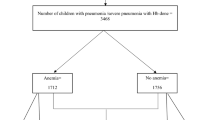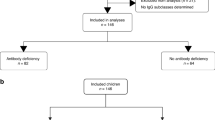Abstract
Objectives: To determine whether subclinical vitamin D deficiency in Indian children under 5 y of age is a risk factor for severe acute lower respiratory infection (ALRI).
Design: A hospital-based case-control study.
Setting: Sanjeevani Paediatrics Hospital, a private hospital in Indapur, India.
Participants: A total of 150 children including 80 cases and 70 controls, aged 2–60 months, were enrolled. Case definition of severe ALRI as given by the World Health Organization was used for cases. Controls were healthy children attending outpatients' service for immunization.
Main outcome measure: Association of serum 25-hydroxyvitamin D3 (25OHD3) with severe ALRI, controlling for demographic and other potential risk factors.
Results: Serum 25OHD3 increased with age. Factors significantly associated with decreased risk of severe ALRI in univariate analysis were: exclusive breastfeeding in the first 4 months (cases 35/78 (45%), controls 41/64 (64%); P=0.02); introduction of other dietary liquids than milk only after 6 months (cases 46/70 (66%), controls 31/66 (47%); P=0.03); use of liquid petroleum cooking fuel (cases 32/80 (40%), controls 40/70 (57%); P=0.04); infant not covered in swaddling cloths when exposed to sunlight before crawling (cases 11/52 (21%), controls 25/54 (46%); P=0.006); and serum 25OHD3 >22.5 nmol/l (cases 16/80 (20%), controls 48/70 (69%); P<0.001). In multivariate analysis, factors associated with significantly lower odds ratio for having severe ALRI were: serum 25OHD3 >22.5 nmol/l (OR: 0.09; 95% CI 0.03–0.24; P<0.001) and exclusive breastfeeding in the first 4 months of life (OR 0.42; 95% CI 0.18–0.99; P=0.046) with age and height/age as significant covariates.
Conclusion: Subclinical vitamin D deficiency and nonexclusive breastfeeding in the first 4 months of life were significant risk factors for severe ALRI in Indian children.
This is a preview of subscription content, access via your institution
Access options
Subscribe to this journal
Receive 12 print issues and online access
$259.00 per year
only $21.58 per issue
Buy this article
- Purchase on Springer Link
- Instant access to full article PDF
Prices may be subject to local taxes which are calculated during checkout
Similar content being viewed by others
References
Agarwal KS, Mughal MZ, Upadhyay P, Berry JL, Mawer EB & Puliyel JM (2002): The impact of atmospheric pollution on vitamin D status of infants and toddlers in Delhi, India. Arch. Dis. Child. 87, 11–13.
Andran N, Yordam N & Ozon A (2002): Risk factors for vitamin D deficiency in breast-fed newborns and their mothers. Nutrition 18, 47–50.
Atiq M, Suria A, Nizami SQ & Ahmed I (1998): Vitamin D status of breastfed Pakistani infants. Acta Paediatr. 87, 737–740.
Banajeh SM, Al-Sunbali NN & Al-Sanhani (1997): Clinical characteristics and outcome of children aged under 5 years hospitalised with severe pneumonia in Yemen. Ann. Trop. Paediatr. 17, 321–326.
Bosch X (1998): Hypercalemia due to endogenous overproduction of active vitamin D in identical twins with cat-scratch disease. JAMA 279, 532–534.
Broor S, Pandey RM, Ghosh M, Maitreyi RS, Lodha R, Singhal T & Kabra SK (2001): Risk factors for severe acute lower respiratory tract infection in under-five children. Indian Pediatr. 38, 1361–1369.
Cantorna MT (2000): Vitamin D and autoimmunity: is vitamin D status an environmental factor affecting autoimmune disease prevalence? Proc. Soc. Exp. Biol. Med. 223, 230–233.
Goswami R, Gupta N, Goswami D, Marwaha RK, Tandon N & Kochupillai N (2000): Prevalence and significance of low 25-hydroxyvitamin D concentrations in healthy subjects in Delhi. Am. J. Clin. Nutr. 72, 472–475.
Haug CJ, Aukrust P, Haug E, Morkrid L, Muller F & Froland SS (1998): Severe deficiency of 1,25-dihydroxyvitamin D3 in human immunodeficiency virus infection: association with immunological hyperactivity and only minor changes in calcium homeostasis. J. Clin. Endocrinol. Metab. 83, 3832–3838.
Holick MF (2002): Too little vitamin D in premenopausal women: why should we care? Am. J. Clin. Nutr. 76, 3–4.
Kumar P (1993): Modified BG Prasad's socio-economic classification. Indian J. Community Med. 18, 60–61.
Lubani MM, Al-Sheb TS, Sharda DC, Quattawi SA, Ahmed SAH, Moussa MA & Reavey PC (1989): Vitamin-D deficiency rickets in Kuwait: the prevalence of preventable disease. Ann.Trop. Paediatr. 3, 134–139.
Monto AS & Lehmann D (1998): Acute respiratory infections (ARI) in children: prospects for prevention. Vaccine 16, 1582–1588.
Muhe L, Lulseged S, Mason KE & Simoes EAF (1997): Case–control study of the role of nutritional rickets in the risk of developing pneumonia in Ethiopian children. Lancet 349, 1801–1804.
National Institute of Nutrition, India (1996): Food composition tables. In Nutritive Value of Indian Foods, eds C Gopalan, BVR Sastri, SC Balasubramanian, pp 45–95. Hyderabad: National Institute of Nutrition, Indian Council of Medical Research.
Pichler J, Gerstmayr M, Szepfalusi Z, Urbanek R, Peterlik M & Willheim M (2002): 1α,25(OH)2D3 inhibits not only Th1 but also Th2 differentiation in human cord blood T cells. Pediatr. Res. 52, 12–18.
Rockett KA, Brookes R, Udalova I, Vidal V, Hill AVS & Kwiatkowski D (1998): 1,25-Dihydroxyvitamin D3 induces nitric oxide synthase and suppresses growth of Mycobacterium tuberculosis in a human macrophage-like cell line. Infect. Immun. 66, 5314–5321.
United State Agency for International Development (2002): Acute Respiratory Infection (ARI) Programs. Global Health—Child Survival. Washington, DC: USAID.
Vitamin A and Pneumonia Working Group (1995): Potential interventions for the prevention of childhood pneumonia in developing countries: a meta-analysis of data from field trials to assess the impact of vitamin A supplementation on pneumonia morbidity and mortality. Bull. WHO 73, 609–619.
Wilkinson RJ, Llewelyn M, Toossi Z, Patel P, Pasvol G, Lalvani A, Wright D, Latif M & Davidson RN (2000): Influence of vitamin D deficiency and vitamin D receptor polymorphisms on tuberculosis among Gujarati Asians in west London: a case–control study. Lancet 355, 618–621.
World Health Organization (1995): The Management of Acute Respiratory Infection in Children: Practical Guidelines for Outpatient Care. Geneva: WHO.
World Health Organization (1998): Complementary Feeding Of Young Children In Developing Countries. Geneva: WHO.
World Health Organization Collaborative Study Team on the Role of Breastfeeding in the Prevention of Infant Mortality (2000): Effect of breastfeeding on infant and child mortality due to infectious diseases in less developed countries: a pooled analysis. Lancet 355, 451–455.
Zinc Investigators' Collaborative Group (1999): Prevention of diarrhea and pneumonia by zinc supplementation in children in developing countries: pooled analysis of randomized controlled trials. J. Pediatr. 135, 689–697.
Acknowledgements
We thank all the parents and children who participated in the study, and the Sanjeevani Paediatrics Hospital, Indapur and Dr L Kadam for their cooperation. We also thank Drs B Mulay, S Doshi and V Ranaware for carrying out laboratory work, and Drs N Thaware, L Hande, R Kavitkar and M Jamdar for their helpful advice and guidance, and S Lewycka, Institute of Child Health, for statistical advice. This work was undertaken in collaboration with Great Ormond Street Hospital for Children NHS Trust, which receives a proportion of its funding from the NHS Executive. Financial support for the work was provided from personal funds in connection with V Wayse's MSc degree at the Institute of Child Health.
Author information
Authors and Affiliations
Contributions
Guarantor: S Filteau.
Contributors: VW was involved in designing the study and collected and analysed the data. SF was involved in study design and statistical analysis. AY was involved in data analysis. KM was involved in data collection. VW and SF wrote the first draft of the paper and all authors contributed to the final draft.
Corresponding author
Rights and permissions
About this article
Cite this article
Wayse, V., Yousafzai, A., Mogale, K. et al. Association of subclinical vitamin D deficiency with severe acute lower respiratory infection in Indian children under 5 y. Eur J Clin Nutr 58, 563–567 (2004). https://doi.org/10.1038/sj.ejcn.1601845
Received:
Revised:
Accepted:
Published:
Issue Date:
DOI: https://doi.org/10.1038/sj.ejcn.1601845
Keywords
This article is cited by
-
Vitamin D3 supplementation as an adjunct in the management of childhood infectious diarrhea: a systematic review
BMC Infectious Diseases (2023)
-
Vitamin D supplementation and lower respiratory tract infection in infants: a nested case–control study
Infection (2023)
-
High burden of hypovitaminosis D among the children and adolescents in South Asia: a systematic review and meta-analysis
Journal of Health, Population and Nutrition (2022)
-
Vitamin D Regulation of Immune Function
Current Osteoporosis Reports (2022)
-
Vitamin D regulation of immune function during covid-19
Reviews in Endocrine and Metabolic Disorders (2022)



